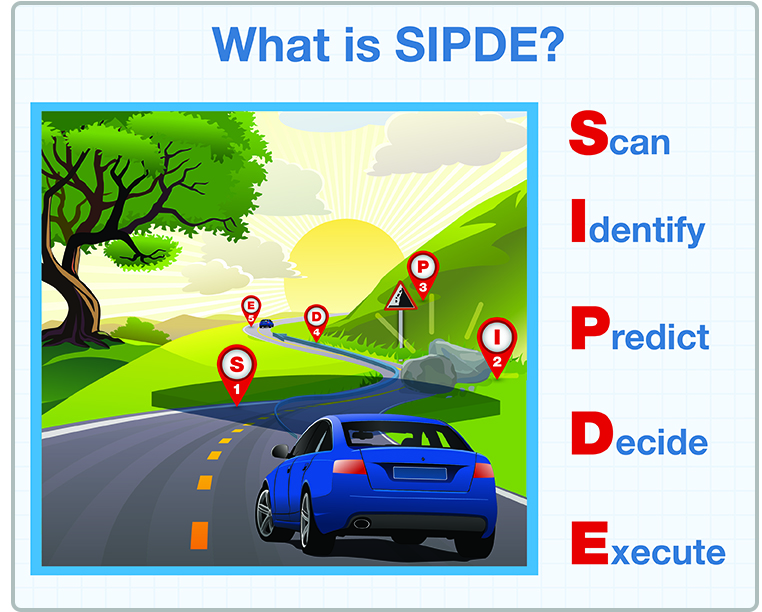Avoiding Collisions and Crashes – Escape Techniques
When it looks like a collision may happen, many drivers panic and fail to act. In some cases they do act, but in ways that do not help to reduce the chance of the collision. There is almost always something you can do to avoid an impending collision or reduce its severity.
In attempting to avoid a collision, drivers must learn to use ESCAPE TECHNIQUES, to avoid or reduce the impact of a collision. Drivers usually have these options:
• Stop (or slow)
• Turn (or steer away)
• Speed up (Yes, this is sometimes your best option)
STOP or SLOW
In order to STOP or SLOW DOWN, you have to use your brakes effectively. Most new vehicles have an Antilock Braking System (ABS) which will allow you to stop without skidding. Consult the owner’s manual of the vehicle you are going drive for information on how to use the ABS – BEFORE YOU PUT THE KEY IN THE IGNITION.
With ABS, a driver must press on the brake pedal as hard as you can and keep pressing on it firmly. You might feel the brake pedal pushing back when the ABS is working. DO NOT let up on the brake pedal. The ABS system will only work with the brake pedal pushed down firmly. Never pump antilock brakes.
CREDIT: Allegro Racing, How ABS (Anti-Lock Brakes) Work
With Conventional Brakes, the driver must apply the brakes as hard as possible without causing the wheels to “lock-up.” You can cause the vehicle to go into a skid if you brake too hard. If the brakes lock-up, you will feel the vehicle start to skid. Quickly let up on the brake pedal. As soon as the vehicle stops skidding, push down on the brake pedal again. Keep doing this until the vehicle has stopped. In case of brake failure, pump the brake pedal quickly.
In most cases, you can TURN the vehicle to avoid a collision quicker than you can stop it. When you don’t have enough room to stop, you may have to steer away from what’s ahead. It’s very important, however, not to oversteer, which may increase risk of skidding or rollovers.
TURN and STEER AWAY
To turn quickly and safely, a driver must NOT apply the brake while you are turning. It’s very easy to lock your wheels while turning. If that happens, you may skid out of control or cause too much weight transfer and rollover. Do not turn any more than needed to clear whatever is in your way. The more sharply you turn, the greater the chances of a skid or rollover. Be prepared to “counter-steer”—that is, to turn the wheel back in the other direction, once you’ve passed whatever was in your path.
CREDIT: Bill Kennedy Driving School, In-Car Emergency Evasive Maneuvers
Keep both hands on the steering wheel. In order to turn quickly, you must have a firm grip on the steering wheel with both hands. It is best to have your hands at the 4 o’clock and 8 o’clock positions. This will keep your wrists and forearms out of the main impact area of the air bag, reduce weight transfer, and is generally more comfortable.
SPEED-UP
Sometimes it is necessary to SPEED UP to avoid or lessen impact forces in a collision. This may happen when another vehicle is about to hit you from the side or from behind and there is room to the front of your vehicle to lessen or change the impact area. Be sure to slow down once the danger has passed.
Always, try to maintain a safe following distance from the vehicle ahead and position yourself to see the bigger picture.
HAVE AN ESCAPE ROUTE
By maintaining a good visual lead, you are able to identify and take action early so you can adjust your speed and space. The main objective is to maintain the greatest possible space around your vehicle.
To drive defensively and prevent collisions, it is important to scan the road by keeping your eyes moving and never focusing on just one point. To help you scan for danger effectively, use the SIPDE technique.

CREDIT: IndianaDriver.com
AVOID MULTIPLE HAZARDS
Sometimes there will be dangers on both sides of the road. You can lessen these multiple hazards by:
- Identifying all potential hazards early. Rate the hazards on the level of threat to your safety.
- Predicting what might happen or go wrong.
- Adjusting your speed and position to make sure you reduce risk.
- Planning escape routes and courses of action before you are faced with a dangerous situation.
CREDIT: NTSA International, Vision and SIPDE
Learn to compare potential threats. For example, there may be parked cars to the right and oncoming cars to the left. In such cases, the best thing to do is to steer a middle course between the oncoming cars and the parked cars. If one danger is greater than the other, give the most room to the biggest threat.
Suppose there are oncoming cars to the left of you and a child on a bike to the right. The child is more likely to make a sudden move. Therefore, give him or her the extra space. It may mean moving closer to the oncoming cars and slowing to reduce risk.
